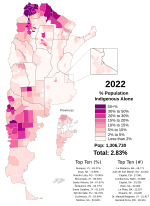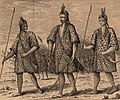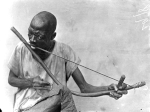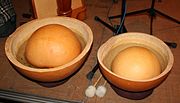Pilagá is a Guaicuruan language spoken by 4,000 people in the Bermejo and Pilcomayo River valleys, western Formosa Province, in northeastern Argentina...
7 KB (741 words) - 19:31, 11 September 2024
Pilagás is a department of the province of Formosa (Argentina). "Argentina: Administrative Division". citypopulation. CENTRO LATINOAMERICANO Y CARIBEÑO...
3 KB (27 words) - 19:34, 24 January 2022
the Greek alphabet (λ). It is used in Heiltsuk, Liqʼwala, Kwakʼwala, and Pilagá. In these languages, Latin lambda represents a variety of lateral phonemes...
2 KB (186 words) - 19:04, 11 September 2024
legendary Sierra del Plata. Native inhabitants of these lands include the Pilagás, Wichis and Tobas, whose languages are still spoken in the province. Sebastian...
21 KB (1,808 words) - 08:58, 7 September 2024
pruinosa var. argentina J. M. Toledo & Barboza is a food source for the Pilagá ethnic group. It is currently the subject of research into the possibility...
3 KB (283 words) - 09:57, 22 May 2024
the bar through the letter B. It is used in Kiowa, Northern Embera and Pilagá languages. The orthography of Northern Embera language used in Panama, the...
3 KB (220 words) - 00:22, 18 August 2024
However, all other parts of the plant are poisonous. Members of the Toba-Pilagá ethnic group of Gran Chaco traditionally eat the ripe fruits raw. Unripe...
8 KB (490 words) - 09:26, 5 September 2024
to much of the area's native population, from the Chulupí, Lengua, Toba-Pilaga, Sanapaná and Ayoreo groups. A modern supermarket is located in the centre...
5 KB (418 words) - 02:31, 13 August 2024
massacre. In the 1968 census 16,548 Tobas and 1,202 of the closely related Pilagás were counted in Argentina. 2,600 Tobas were living in Bolivia. 3,000 to...
14 KB (1,845 words) - 15:15, 8 January 2023
parts of Santiago del Estero Province. Charrúa Lule Mbya-Guaraní Mocoví Pilagá Toba Tonocoté Vilela Wichí Guaycuru This region includes the provinces of...
37 KB (2,951 words) - 05:56, 17 September 2024
but important peoples are the Quechua (6,739), the Charrúa (4,511), the Pilagá (4,465), the Chané (4,376), and the Chorote (2,613). The Selk'nam (Ona)...
241 KB (24,696 words) - 07:25, 4 September 2024
number words other than 'one'. These include Nadëb, pre-contact Mocoví and Pilagá, Culina and pre-contact Jarawara, Jabutí, Canela-Krahô, Botocudo (Krenák)...
58 KB (3,588 words) - 16:32, 30 August 2024
a people Languages Abipón (Callaga) Religion Animism, Shamanism, later Christianity Related ethnic groups Toba, Pilagá, Mocoví, other Guaycurú peoples...
7 KB (851 words) - 12:44, 9 May 2024
Kusunda of Nepal: [ʕ] the Papuan language Teiwa: [ħ] the Guaicuruan language Pilagá: [ʕ] the Mayan language Achi: [ʕ] the Siouan language Stoney (Nakoda): [ħ]...
19 KB (1,801 words) - 15:42, 25 August 2024
Formosa, in the south of Chaco and the Northeast of the Santa Fe Province. Pilagá is from the Mataco-Guaicuru family and is spoken by some 2,000 to 5,000...
39 KB (3,291 words) - 08:17, 3 July 2024
Cased forms of the IPA letter in the Pilaga alphabet. They have been accepted by Unicode....
11 KB (651 words) - 21:53, 27 August 2024
settlement in Chaco Province, Argentina El Espinillo, Formosa, capital of the Pilagás Department, in Formosa Province, Argentina This disambiguation page lists...
426 bytes (79 words) - 20:33, 7 December 2013
Cased forms of the IPA letter in the Pilagá alphabet. The capital is not supported by Unicode....
26 KB (1,469 words) - 14:15, 2 May 2024
aboriginal tribes who inhabited this region were the Tobas, Timbúes, Mocovíes, Pilagás, Guaycurúes, and Guaraníes. They were nomadic, lived from hunting, fishing...
34 KB (3,193 words) - 00:36, 13 August 2024
Paraguay Mbayá (Caduveo), historic Kadiweu, Brazil Mocoví (Mocobí), Argentina Pilagá (Pilage Toba) Toba (Qom, Frentones), Argentina, Bolivia, and Paraguay Kaiwá...
31 KB (2,629 words) - 13:00, 29 August 2024
28 September 2017 (2017-09-28) (Argentina) Running time 115 minutes Countries Argentina Spain Languages Spanish Qom Pilagá Mbyá Guaraní Box office $475,910...
15 KB (1,570 words) - 12:02, 15 August 2024
Peru. Latajkiaswolé is the name of a musical bow found among the Wichi, Pilaga, and other tribes of the Gran Chaco region of South America. In the United...
20 KB (2,325 words) - 14:12, 9 September 2024
Chaco (1870–1917) Argentina Abipones Tribes Guaycuru Tribes Wichí Toba Pilagá Mocoví Victory Annexation of a big part of the Gran Chaco Tenth Argentine...
74 KB (448 words) - 12:22, 15 June 2024
(Caduveo), historic Kadiweu, Brazil Mocoví (Mocobí), Argentina Payaguá Pilagá (Pilage Toba) Toba (Qom, Frentones), Argentina, Bolivia, and Paraguay Kaiwá...
31 KB (3,217 words) - 02:49, 17 June 2024
approximately 19,810 (2000 WCD) speakers reside. The language is distinct from Toba-Pilagá and Paraguayan Toba-Maskoy. There are also 146 Toba speakers in Bolivia...
14 KB (1,576 words) - 01:43, 19 August 2024
Tapieté | |____ Guaycuruan family | | |___ Qom group | | |___ Mocoví | | |___ Pilagá | | |___ Toba | |____ Mataguayo ("Mataco") family | | |____Wichí group ("Mataco")...
14 KB (1,322 words) - 07:43, 23 November 2023
Mapuche 113,680 18.8% Mbyá 8,223 1.4% Mocoví 15,837 2.6% Omaguaca 1,553 0.3% Pilagá 4,465 0.7% Puelche 1,585 0.3% Qom 69,452 11.5% Quechua 6,739 1.1% Rankulche...
97 KB (4,828 words) - 22:41, 15 September 2024
are somewhat poisonous. Members of the Toba-Pilagá culture of Gran Chaco consume the fruit raw. Toba-Pilagá children burst the fruits of Physalis pubescens...
5 KB (427 words) - 02:41, 29 August 2024
Chorote people, the rhizomes are also used by Wichi, Western Toba, and Pilagá. It is suitable for cultivation in the USDA zones 9a - 10a. Nymphaea jamesoniana...
8 KB (617 words) - 04:27, 27 August 2024
America, the cataquí is a water drum used by the Toba (aka Qom), Wichí, Pilagá, Chorote and Nivaclé cultures in the South American Gran Chaco region. The...
9 KB (915 words) - 13:04, 11 February 2024






















